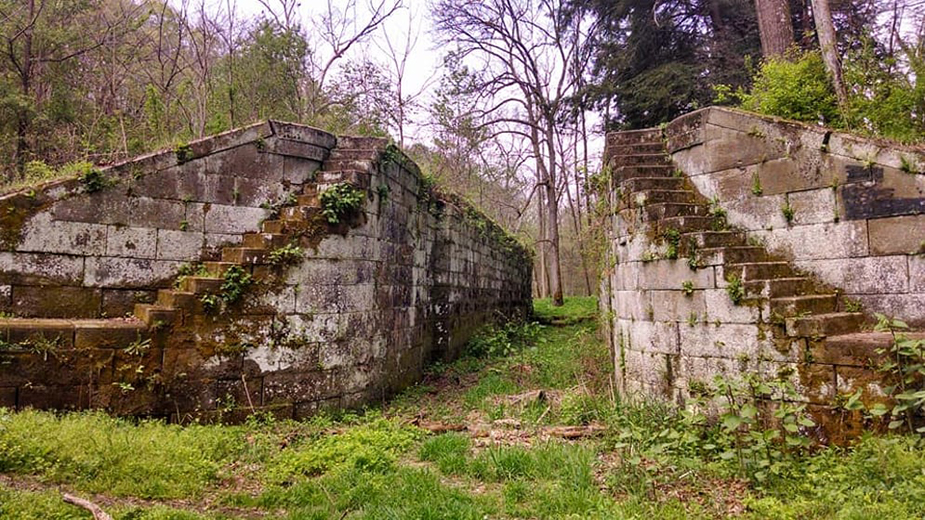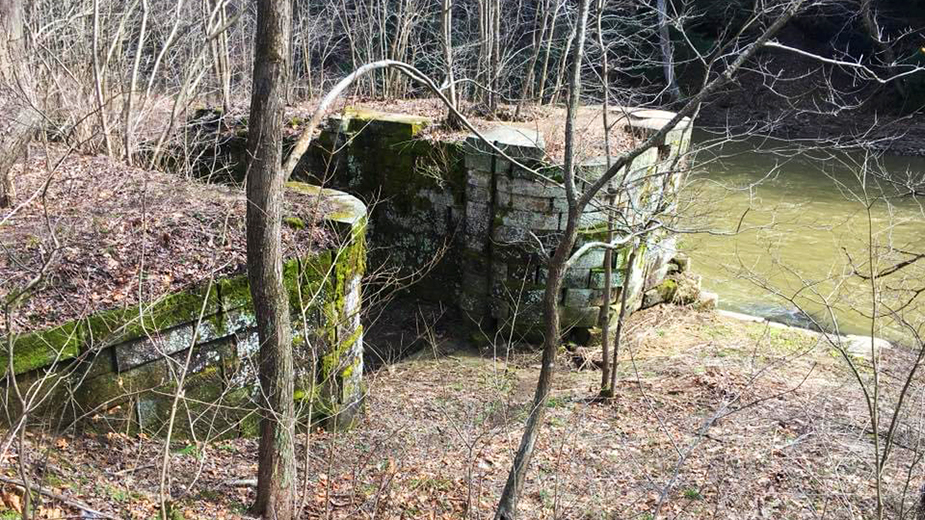CALCUTTA, Ohio – There is a section of Little Beaver Creek in Columbiana County just north of Calcutta that flattens out, flowing east before meandering southward toward the Ohio River.
Here – as evidenced elsewhere along the waterway and within the scenic Beaver Creek State Park – are remnants of an engineering feat that began nearly 200 years ago.
Some of the abandoned locks along the former Sandy and Beaver Canal – begun in the mid-1830s – are today remarkably preserved. Aside from overgrown vegetation and brush that’s claimed portions of these sites, the precision stonework and craftsmanship has survived the pressures of nature and time.
One lock in particular has become embedded in the DNA of Columbiana County folklore: “Gretchen’s Lock,” situated along that flat stretch of Beaver Creek and a place shrouded in ghoulish fiction.
First, here’s the legend.
Edward H. Gill, an experienced engineer from either Holland or Germany, legend says, was hired to oversee the initial construction phase of the Sandy and Beaver Canal – a proposed waterway to link the Ohio and Erie Canal at Bolivar, Ohio, with Glasgow, Pa., along the Ohio River, approximately 40 miles below Pittsburgh.
The first phase of its construction was to begin in Columbiana County, using portions of the Little Beaver as part of the route.
During his passage from Europe to the United States, Gill’s wife became ill, died and then was buried at sea. He and his daughter, Gretchen, found a home in Columbiana County as he began work on the canal in 1835.
Not long after, his daughter Gretchen contracted malaria and also died. Overcome with grief, Gill entombed her in the wall of Canal Lock #41, henceforth known as “Gretchen’s Lock.” When he resigned his position after the Panic of 1837 brought building to a standstill, Gill disinterred his daughter and loaded her coffin on a ship bound for Europe. That ship sank during a violent storm and all on board were lost.
To this day, the ghost of Gretchen Gill is rumored to haunt the site of the old canal lock, her first resting place.
Like most tall tales, ghost stories such as Gretchen’s Lock are seeded with some semblance of truth. Indeed, there was an Edward H. Gill, an experienced and talented engineer who was recruited to spearhead work on the new Sandy and Beaver Canal.
Only there was never a Gretchen.
“The real Gill and his wife never had children,” says Jennifer Simpson, a volunteer at the Beaver Creek State Park. Nor did Gill’s wife perish at sea. “He and his wife lived a long life.”
AN EXPERT BUILDER
Gill, likely born in Ireland sometime in 1805, arrived in the United States as a boy. During the 1820s, he and his father worked together helping to build the Erie Canal, the 351-mile waterway that connects the Hudson River at Albany, N.Y., with the Niagara River near Buffalo and the Great Lakes. The engineering marvel, completed in 1825, transformed the economy of the entire state and turned New York City into a commercial powerhouse. Gill then worked on the Ogeechee and Alatamaha Canal in Savannah, Ga.

“When work ended at the Erie Canal, Gill obtained a job with the city of Philadelphia’s engineering department,” says Doug Bacso, a retired engineer in the Cleveland area who has studied the history of the Sandy and Beaver. Meanwhile, Philadelphia, once the country’s busiest city and port, saw its trade siphoned as more goods were diverted through New York after the canal opened for business.
“The Sandy and Beaver was Philadelphia’s response to the Erie Canal,” Bacso says. The idea was to link the Ohio and Erie Canal to the Ohio River northwest of Pittsburgh. (The Ohio flows northwest before sloping southwest to the Mississippi.) In its path are the cities of Lisbon (then, New Lisbon) Hanoverton (then, Hanover), and other Columbiana County communities.
The plan was to open more commercial traffic into Pennsylvania via the existing canal systems across that state, feeding into Philadelphia. Although the Philadelphia Board of Trade selected another competing project, the Pennsylvania and Ohio Canal, as a more logical effort to back, work on the Sandy and Beaver persisted and the Ohio Legislature chartered the project in 1828.
The Sandy and Beaver Canal was an entirely private venture, drawing in Philadelphia banking interests as well as local investors in Columbiana County, mostly from Lisbon. Gill – in his late 20s and already an experienced engineer – was tapped to head the project’s first phase.
“Gill was very meticulous. His stonework was top-notch,” Bacso says. Work on the canal began in 1835 and several locks were completed.
Bacso says it’s impossible to determine just how many workers – many of them local – were involved in construction of the canal, although some sources he’s reviewed point to approximately 1,200.
The board of the canal, headquartered in Lisbon, and its investors kept close watch on its progress. The canal’s first director was Benjamin Hanna, the grandfather of Marcus Hanna, the Cleveland industrialist and political operative who helped to manage William McKinley’s successful bids for the presidency in 1896 and 1900.
“He was a merchant in New Lisbon and one of the main backers of the canal,” Bacso says of Benjamin Hanna.
According to Bacso, Hanna would often split his time between Columbiana County and Philadelphia, lobbying for additional financing and investment.
When Hanna died, his son, Dr. Leonard Hanna and father of Marcus, assumed the director’s seat.
Bacso describes construction of the first phase of the canal under Gill’s direction as “perfect.” It featured the ingenious civil engineering and construction of two tunnels – a large one 900 feet in length at Hanoverton and a smaller one at Dungannon.
“It was very unique for Ohio,” he says. Among the remaining canal locks that showcase Gill’s workmanship is “Lusk’s Lock” at Beaver Creek State Park.

Gill had also at one time owned property at what was then named “Gill’s Ford,” today Guilford Lake. Others, lured by the promise of new business as the canal took shape, relocated to Columbiana County.
PANIC AND DECLINE
Work on the canal progressed until 1837, when the financial crisis of that year dried up investment and funding. Discouraged, Gill left the project and headed east to Richmond, Va. By the early 1840s, others had also abandoned the project, including Leonard Hanna, who would cut his losses and move his family to Cleveland, where he joined his brother in the grocery business.
Once work resumed on the canal after 1838, Bacso says the venture began to cut corners. The quality of the work especially suffered in the face of Gill’s absence. Problems then plagued the project.
“There was never enough money for maintenance,” he says. “Every year there were structures – a dam would have a problem, for example,” he says, and the post-Gill locks were prone to leaking.
Moreover, when construction on the Sandy and Beaver finished in 1848, the days of the canal era were already numbered, Bacso says. Railroads – especially the Cleveland and Pittsburgh Railroad – began to stitch portions of the state and country together, bypassing internal waterways as the preferred mode of transporting goods. Plus, the Sandy and Beaver never directly connected with the Pennsylvania canal system, he says.
“Another factor was that there was no real commerce,” Bacso says, because the canal lacked a major anchor city along its route. “There was no real industry other than agriculture,” he says, adding that shipping activity quieted between harvests.
The final blow came in 1852, when the dam at Guilford Lake burst, flooding the canal works for good.
‘PRINT THE LEGEND’
As for Edward Gill, he and his wife relocated to Richmond in 1837, where he worked in several positions before accepting that of superintendent for the Virginia Central Railroad in that city during the late 1850s, Beaver Creek State Park’s Simpson says.
“He switched to the railroads,” Simpson says.
In fact, it was Gill who served as superintendent of the Richmond and Pittsburgh Railroad during the Civil War, often in direct correspondence with Gen. Robert E. Lee as the Army of the Potomac closed in during the last year of the Confederacy.
A telegram to Gill from Lee, dated June 18, 1864, at 3:30 a.m., asks, “Can trains run through to Petersburg?” after the Union siege of that city began nine days earlier.
After the war, in November 1865, it was Gill who sent an update to President Andrew Johnson apprising him on the status of railroad reconstruction.
Gill died in 1868 at age 63 and is buried in Hollywood Cemetery in Richmond.
So, how is it that a distinguished engineer who clearly lived out a full, well-documented life became the source of a macabre ghost tale?
No one is sure how the tale was born but Simpson traces the first printed “Gretchen’s Lock” story to an account written by industrialist Ira Mansfield of Darlington, Pa., at the turn of the 20th century.
“I found where he had published it in one of his books,” she says. “That’s the earliest that I’ve ever traced it.”
The story was perpetuated in 1952 with the publication of “The Sandy and Beaver Canal” by R. Max Gard and William Vodrey Jr., according to Simpson.
“There have been variations of the tale,” she says. “The shame of it is that people have been digging at that lock for decades and decades,” damaging it in the process.
Perhaps the odyssey of the story is best reflected during the closing moments of John Ford’s 1962 film classic, “The Man Who Shot Liberty Valance.”
In that scene, Jimmy Stewart’s character, U.S. Sen. Ransom Stoddard, tells a newspaper editor the truth that it was his friend, Tom Doniphan (John Wayne), and not he who shot and killed the outlaw Liberty Valance 25 years earlier – an incident from which Stoddard built his political reputation.
Upon hearing his confession, the newspaperman rips up his notes, knowing full well that if the true story were printed, it would ruin the senator’s political career.
“When the legend becomes fact, print the legend,” the editor says.
Some people in Columbiana County, however, still shake their heads in disbelief.
“People just love their ghost stories, I guess,” Simpson says.
Pictured at top: The remnants of “Gretchen’s Lock” along the former Sandy and Beaver Canal.

